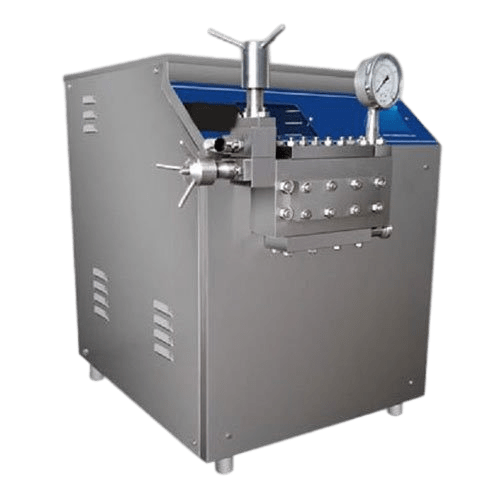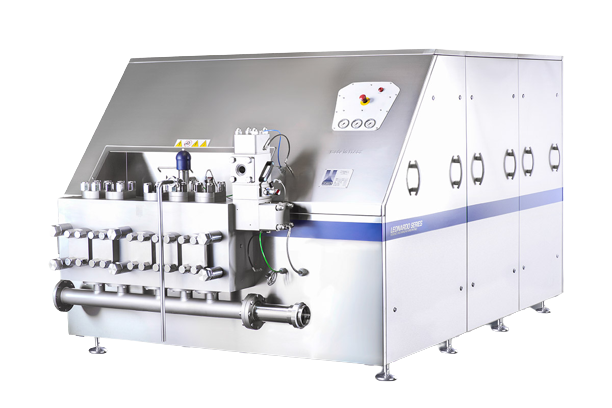Homogenizer
The homogenizer is used to homogenize dairy products such as milk. This device causes the uniform distribution of fat in the milk. The homogenization process improves the quality of milk. It also prevents contamination and bacteria from entering the milk. In general, the homogenization process is used to make a completely homogeneous mixture of two liquid products or one liquid product and one solid product.
Most of the applications of this device are in the food industry, especially dairy. The homogenizer actually transforms the materials into very small and uniform sizes. The team of Sepyani Industrial Group, active in the field of industrial automation, introduces this device and its maintenance and optimization conditions in this article. Stay with us in the future.
Different types of Pasteurizer
What is a homogenizer?
This device is one of the equipment used in laboratories. The use of this device causes the quality of the product to be higher compared to the old methods, and it also causes much less environmental pollution. For this reason, the spread of diseases will occur much less. This device is also less noisy than older models. Most of the applications of this device are related to the food industry, pharmaceutical and chemical industries.
History of the homogenizer
This device was invented and patented by Gulin in 1899. The device made by him had a piston pump. that the material in question was pressurized by one or more capillary tubes. He showed his invention for the first time at the World Exhibition in Paris. His machine was made to homogenize milk. And it was used for this purpose. But later, the application of this device was extended to the medical and chemical industries.
Applications of the homogenizer
This device has many uses. Among these applications, we can see:
- Dispersing nanoparticles in liquids
- Stable suspensions
- Protein processing
- Extraction
This device is used in many scientific and research fields. Sectors such as biotechnology, food and beverage control, pharmaceuticals, food industry and veterinary medicine. This device is used to crush materials such as plants, soil and food. But the oldest and most widely used is the use of a homogenizer to make milk uniform. With the help of this device, it is evenly distributed in all parts of the milk, and this makes the quality of the milk better and its shelf life longer.
Homogenizer components
There are different types of this device, each of which has special parts based on its built-in capabilities and features. But in general, this device is made of three main parts. These three sections include:
- The main body of the homogenizer
- A special part of the sample made of different dimensions and materials. Of course, most of the time it is made of stainless steel or Teflon materials.
- Metal ball in different sizes
How does the homogenizer work?
If the desired material is solid, this device first converts it into smaller dimensions with the help of metal balls in special containers. For this purpose, the intensity of the oscillation in the device (in Hertz) and the duration of the oscillation must be set. At this stage, the container containing the solid material or the so-called sample will start to move vigorously. As a result of these fluctuations, the metal spheres and the sample material collide with each other and this causes it to be divided into small particles.
Application of homogenizer in dairy industry
As mentioned, one of the oldest uses of this device is in the dairy industry. Since they usually mix the milks of multiple cattle farms and cow herds to have a more compatible raw milk for the preparation of dairy products. This causes the milk fat to separate from the milk and accumulate on top of it.
By means of a homogenizer, the milk is homogenized into a stable emulsion. This makes the fat in it not accumulate as a separate layer on top of the milk surface. This process causes fat globules to be created in very small sizes at first. and then causes it to mix in the liquid part of the milk. Homogenizing milk reduces the fat in the cream and milk head.
At the same time as the milk is homogenized in this device, existing microbes and contaminations are not able to stay in the milk and are quickly destroyed. Also, the milk does not settle in any way and comes out of the device in a completely uniform way. To learn more about the equipment used in the dairy production line, refer to the article titled General and suitable solutions for the maintenance and repair of the dairy production line.
To prepare and buy this device, you can contact the experts and consultants of Sepyani Industrial Group. Sepyani Industrial Group, with skilled engineers and having a brilliant history in the field of plc industrial automation and industrial electricity, as well as consulting and setting up the production line, provides the best services in this field.
Types of homogenizers:
- Ultrasonic homogenizer
- Mechanical homogenizer
- High pressure homogenizer
- Vacuum homogenizer
Each of these types are used in some industries. In the following, we will introduce different types of this device.
1- Ultrasonic homogenizer device
This device is also called an ultrasonic homogenizer. The ultrasonic homogenizer is able to convert electrical current into mechanical vibrations. In this way, it causes homogenization of liquids. The working method of this type of homogenizer is that it creates pressure in the liquid medium by creating strong waves. These so-called pressure waves cause flow in the liquid. By creating suitable conditions, the phenomenon of cavitation occurs.
In fact, by exploding the bubbles created in the liquid, it causes an impact in the desired liquid and the energy from the explosion of the bubbles causes the breaking of the covalent bonds in the liquid. This force, together with the turbulent currents caused by sound vibrations, causes cell destruction and homogenization.
2- Mechanical homogenizer
This type of homogenizer is used for various purposes. From pharmaceutical and food industries to textile and chemical industries, all of them use this type of device to homogenize and make coatings of materials and make solutions. The working method of this type of homogenizer is that the rakes move quickly and cause the particles to be compressed and broken. In this way, the particles of thick and so-called super viscous materials can be homogenized in a short period of time.
3- Pressure homogenizer
This device is usually used for liquids. Therefore, special equipment has been used in its design and construction. The most common use of this type of homogenizer is in the food industry, especially dairy. The way of working is that the desired sample is placed behind a high pressure valve.
For particles to pass, the distance can be adjusted by the valve. The reciprocating movements of the pistons cause the sample to be compressed. The pressure difference between the two sides of the valve causes turbulence in the particles. This turbulence causes the particles to hit each other strongly and as a result, homogeneous composites are formed. In this way, the output will not change in terms of natural characteristics (color, solubility and stability).
4- Vacuum homogenizer
This device is used for food and cosmetic industries. This machine is able to produce all kinds of emulsions and suspensions.
Maintenance of the homogenizer:
This device in any type and model needs maintenance and optimization like other industrial equipment. In this way, the maximum efficiency of the device is maintained. For this purpose, the best thing is to get help from a professional team. A team that provides appropriate and continuous support services. Sepyani team engineers will increase the life of your device by following the standard principles in the maintenance and repair of your device. It also increases efficiency and effectiveness.
Effect of homogenization on milk:
Homogenization in dairy products, especially milk, can bring many advantages. Benefits such as:
- Cream will not form in the head of the milk because the fat cells will shrink.
- The milk turns white.
- Oxidation in the milk will decrease.
- The milk gets a better flavor.
- Increased shelf life
Of course, the homogenization process can also bring some problems. For example, homogenized milk may not be suitable for making hard and semi-hard cheese. Because it is not possible to clot. Also, sensitivity to light appears in milk, which causes it to acquire a special taste against the sun’s rays.
Conclusion:
The homogenizer is a very widely used equipment in various industries. Of course, its main use is in the dairy industry and milk homogenization. This device is used to homogenize materials (most often liquids). The type and way of working in this device has created different divisions for it. Of course, like any other equipment, it needs necessary maintenance and support so that it can always be used at its maximum efficiency. To get more information, you can complete the consultation request form so that our technicians will contact you as soon as possible. Also you can contact through What’sApp.



